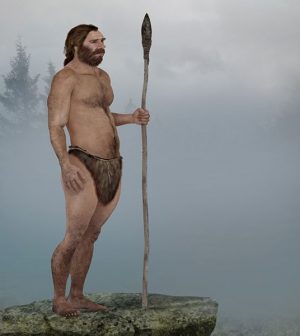- Skip Storing This Everyday Product in the Fridge Door
- Green Tea + B3 Pairing May Boost Brain Health
- Navigating Your Midlife Crisis: Embracing New Possibilities
- City Raccoons Showing Signs of Domestication
- Mapping the Exposome: Science Broadens Focus to Environmental Disease Triggers
- One Week Less on Social Media Linked to Better Mental Health
- Your Brain Changes in Stages as You Age, Study Finds
- Some Suicide Victims Show No Typical Warning Signs, Study Finds
- ByHeart Formula Faces Lawsuits After Babies Sickened With Botulism
- Switch to Vegan Diet Could Cut Your Greenhouse Gas Emissions in Half
Early Humans Grew Taller Long Before Bulking Up

As humans evolved, height and weight developed at different rates.
That’s the conclusion of researchers who analyzed 311 fossil specimens of modern-day human’s hominin ancestors, dating from 4.4 million years ago to humans who lived after the last ice age.
Hominin evolution was a “long and winding road with many branches and dead ends” that included bursts of growth followed by long periods of little change, according to the study, published in the journal Royal Society Open Science.
For a long time, hominin height and weight evolved roughly in concert. But about 1.5 million years ago, hominins gained about 10 centimeters (about 4 inches) in height but did not consistently boost their weight for another million years, with an average increase of 10 to 15 kilograms (about 22 to 33 pounds) occurring about 500,000 years ago.
“An increase solely in stature would have created a leaner physique, with long legs and narrow hips and shoulders,” the study’s lead author, Manuel Will, from the archaeology department at the University of Cambridge, in England, said in a university news release.
“This may have been an adaptation to new environments and endurance hunting, as early Homo species left the forests and moved on to more arid African savannah,” he added.
“The higher surface-to-volume ratio of a tall, slender body would be an advantage when stalking animals for hours in the dry heat, as a larger skin area increases the capacity for the evaporation of sweat,” Will explained.
“The later addition of body mass coincides with ever-increasing migrations into higher latitudes, where a bulkier body would be better suited for thermoregulation in colder Eurasian climates,” he said.
Increases in human body size may continue, according to study co-author Jay Stock, also from the university’s archaeology department.
“Many human groups have continued to get taller over just the past century,” Stock said in the news release. “With improved nutrition and health care, average statures will likely continue to rise in the near future.”
However, he noted, “there is certainly a ceiling set by our genes, which define our maximum potential for growth.”
More information
The Smithsonian’s National Museum of Natural History has more on human evolution.
Source: HealthDay
Copyright © 2025 HealthDay. All rights reserved.










